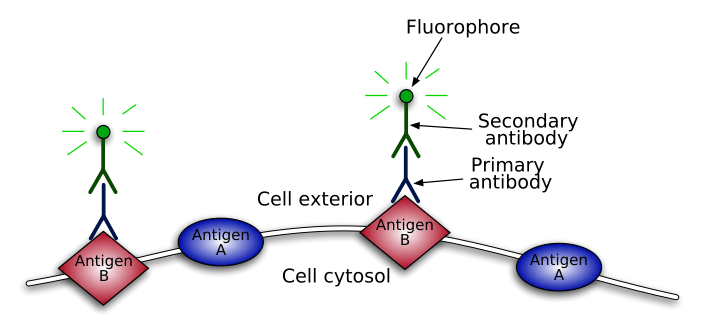Key Difference – Primary vs Secondary Antibody
Antibodies are Y shaped proteins or immunoglobulins produced by plasma cells. Antibodies have the ability to identify antigens, which are foreign molecules such as pathogens, toxins, etc., and successfully neutralize the threat posed by them. The antibody structure is composed of a portion known as paratope (antigen binding site present in the tip of the ‘Y’ shaped structure) to identify and bind to the complementary structure of the antigen which is known as an epitope. Paratope and epitope work as ‘lock’ and ‘key,’ respectively. This allows the proper binding of the antigen to the antibody. The effect by the antigen is directly proportional to the type of antigen. Once an antibody is bound to an antigen, it activates other immune responses like the action of macrophages to destroy the foreign pathogenic agent. For activation, an antibody communicates with the other components of the immune system by the Fc region present in the base of the ‘Y’ shaped structure of the antibody. There are five different types of antibodies: IgM, IgG, IgA, IgD, and IgE. According to the mechanism of binding of an antibody to an antigen (directly or indirectly), there are two types of antibodies known as primary antibody and secondary antibody. The primary antibody has the ability to bind directly to the antigen whilst a secondary antibody doesn’t bind to the antigen directly but interacts through the binding to a primary antibody. This is the key difference between primary and secondary antibody.
CONTENTS
1. Overview and Key Difference
2. What is a Primary Antibody
3. What is a Secondary Antibody
4. Similarities Between Primary and Secondary Antibody
5. Side by Side Comparison – Primary vs Secondary Antibody in Tabular Form
6. Summary
What is a Primary Antibody?
A primary antibody can be defined as an immunoglobulin that specifically binds to proteins. It is the antibody that binds directly to the antigen. This is accomplished by the recognition of an epitope present on the antigen by the variable region of the primary antibody. They are developed as polyclonal and monoclonal antibodies. These antibodies are useful for research purposes to detect biomarkers for diseases such as diabetes, cancer, Alzheimer’s disease and Parkinsons’s disease. A fluorophore or an enzyme is not present in the primary antibody.

Figure 01: Primary Antibody
In order for the researcher to visualize the antigen, it should be combined with further reagents like secondary antibodies. It is also important to study absorption, distribution, metabolism, and excretion (ADME) and multi-drug resistance (MDR) of several therapeutic agents. Primary antibodies are in various forms which range from crude antiserum to antigen-purified preparations; thus they are produced and supplied accordingly. Commercially available primary antibodies are normally biotin labeled or fluorescently labeled.
What is a Secondary Antibody?
Secondary antibodies are bound to the heavy chains of the primary antibodies to aid in the detection, sorting, and purification of target antigens. Secondary antibodies do not interfere with the binding procedure of the primary antibodies with the antigens. It does not bind directly to the antigen. Once the primary antibodies are bound directly to the target antigens, secondary antibodies come and bind to the primary antibodies. The secondary antibody should be specific to the antibody species and to the isotope of the primary antibody during the antigen detection purpose. The type of secondary antibody is selected by the primary antibody class, the source host, and the preferred label. Most primary antibody classes are of IgG class.

Figure 02: Secondary Antibody
For research purposes, secondary antibodies are used in various types of assays such as ELISA or Western blotting, Flow Cytometry, and Immunohistochemistry, etc.
What are the Similarities Between Primary and Secondary Antibody?
- Primary and secondary antibodies are involved in immune responses.
- Both share the typical structure of an antibody.
What is the Difference Between Primary and Secondary Antibody?
Primary vs Secondary Antibody | |
| Primary antibody is an immunoglobulin that specifically binds to a particular protein or another biomolecule of research interest for the purpose of purifying or detecting and measuring. | Secondary antibody is a type of antibody which binds indirectly with antigens through the binding with primary antibodies to assist in detection, sorting, and purification of target antigens. |
| Interactions with Antigen | |
| Primary antibodies bind directly to the antigen. | Secondary antibody does not bind directly to the antigen but interacts through the binding with the primary antibody. |
| Function | |
| Primary antibodies are used as biomarkers for detection of disease conditions like cancer, diabetes, Alzheimer’s disease, Parkinsons’s disease, etc. | Secondary antibodies are used in immunolabeling. |
Summary – Primary vs Secondary Antibody
Antibodies are immunoglobulins which play a major role in the immune system. They have a ‘Y’ shaped structure and identify foreign substances; antigens, to detect the presence of pathogenic organisms and successfully eliminate them without allowing the pathogens to cause harm to the host organism. Antibodies are of five different types; IgM, IgG, IgA, IgD, and IgE and according to the type of binding of an antibody with an antigen (directly or indirectly), antibodies are of two types; primary antibody and secondary antibody. Primary antibodies have the ability to bind to the antigen directly whilst a secondary antibody doesn’t bind to the antigen directly but forms interactions through binding to the primary antibody. This is the difference between primary and secondary antibody.
Download PDF Version of Primary vs Secondary Antibody
You can download PDF version of this article and use it for offline purposes as per citation note. Please download PDF version here Difference Between Primary and Secondary Antibody.
References:
1.“What Is An Antibody?” Www.bioprocessonline.com, Available here. Accessed 23 Aug. 2017.
Image Courtesy:
1. “Primary-Secondaryantibody” By David Munch (CC BY-SA 3.0) via Commons Wikimedia
2. “Elisa tipus” By Carolfv333 – Own work (CC BY-SA 4.0) via Commons Wikimedia
ncG1vNJzZmivp6x7pbXFn5yrnZ6YsqOx07CcnqZemLyue8OinZ%2Bdopq7pLGMm5ytr5Wau2680aKkmqqpYq6vsIyvqmarlZi8r7DAq7BmmZ6ptqO7w7Jm